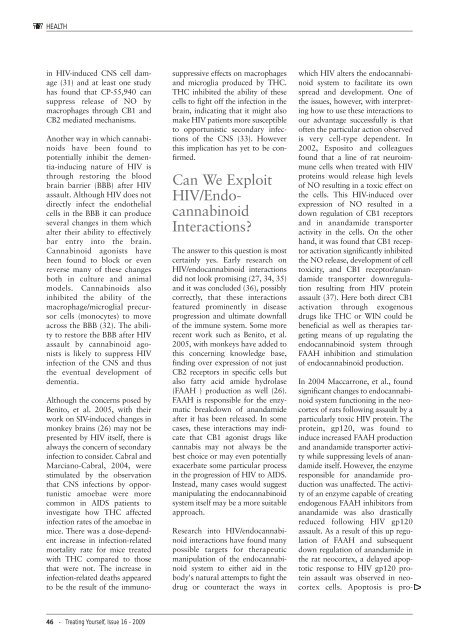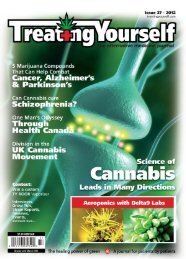Create successful ePaper yourself
Turn your PDF publications into a flip-book with our unique Google optimized e-Paper software.
HEALTH<br />
in HIV-induced CNS cell damage<br />
(31) and at least one study<br />
has found that CP-55,940 can<br />
suppress release of NO by<br />
macrophages through CB1 and<br />
CB2 mediated mechanisms.<br />
Another way in which cannabinoids<br />
have been found to<br />
potentially inhibit the dementia-inducing<br />
nature of HIV is<br />
through restoring the blood<br />
brain barrier (BBB) after HIV<br />
assault. Although HIV does not<br />
directly infect the endothelial<br />
cells in the BBB it can produce<br />
several changes in them which<br />
alter their ability to effectively<br />
bar entry into the brain.<br />
Cannabinoid agonists have<br />
been found to block or even<br />
reverse many of these changes<br />
both in culture and animal<br />
models. Cannabinoids also<br />
inhibited the ability of the<br />
macrophage/microglial precursor<br />
cells (monocytes) to move<br />
across the BBB (32). The ability<br />
to restore the BBB after HIV<br />
assault by cannabinoid agonists<br />
is likely to suppress HIV<br />
infection of the CNS and thus<br />
the eventual development of<br />
dementia.<br />
Although the concerns posed by<br />
Benito, et al. 2005, with their<br />
work on SIV-induced changes in<br />
monkey brains (26) may not be<br />
presented by HIV itself, there is<br />
always the concern of secondary<br />
infection to consider. Cabral and<br />
Marciano-Cabral, 2004, were<br />
stimulated by the observation<br />
that CNS infections by opportunistic<br />
amoebae were more<br />
common in AIDS patients to<br />
investigate how THC affected<br />
infection rates of the amoebae in<br />
mice. There was a dose-dependent<br />
increase in infection-related<br />
mortality rate for mice treated<br />
with THC compared to those<br />
that were not. The increase in<br />
infection-related deaths appeared<br />
to be the result of the immuno-<br />
46 - <strong>Treating</strong> <strong>Yourself</strong>, <strong>Issue</strong> 16 - 2009<br />
suppressive effects on macrophages<br />
and microglia produced by THC.<br />
THC inhibited the ability of these<br />
cells to fight off the infection in the<br />
brain, indicating that it might also<br />
make HIV patients more susceptible<br />
to opportunistic secondary infections<br />
of the CNS (33). However<br />
this implication has yet to be confirmed.<br />
Can We Exploit<br />
HIV/Endocannabinoid<br />
Interactions?<br />
The answer to this question is most<br />
certainly yes. Early research on<br />
HIV/endocannabinoid interactions<br />
did not look promising (27, 34, 35)<br />
and it was concluded (36), possibly<br />
correctly, that these interactions<br />
featured prominently in disease<br />
progression and ultimate downfall<br />
of the immune system. Some more<br />
recent work such as Benito, et al.<br />
2005, with monkeys have added to<br />
this concerning knowledge base,<br />
finding over expression of not just<br />
CB2 receptors in specific cells but<br />
also fatty acid amide hydrolase<br />
(FAAH ) production as well (26).<br />
FAAH is responsible for the enzymatic<br />
breakdown of anandamide<br />
after it has been released. In some<br />
cases, these interactions may indicate<br />
that CB1 agonist drugs like<br />
cannabis may not always be the<br />
best choice or may even potentially<br />
exacerbate some particular process<br />
in the progression of HIV to AIDS.<br />
Instead, many cases would suggest<br />
manipulating the endocannabinoid<br />
system itself may be a more suitable<br />
approach.<br />
Research into HIV/endocannabinoid<br />
interactions have found many<br />
possible targets for therapeutic<br />
manipulation of the endocannabinoid<br />
system to either aid in the<br />
body's natural attempts to fight the<br />
drug or counteract the ways in<br />
which HIV alters the endocannabinoid<br />
system to facilitate its own<br />
spread and development. One of<br />
the issues, however, with interpreting<br />
how to use these interactions to<br />
our advantage successfully is that<br />
often the particular action observed<br />
is very cell-type dependent. In<br />
2002, Esposito and colleagues<br />
found that a line of rat neuroimmune<br />
cells when treated with HIV<br />
proteins would release high levels<br />
of NO resulting in a toxic effect on<br />
the cells. This HIV-induced over<br />
expression of NO resulted in a<br />
down regulation of CB1 receptors<br />
and in anandamide transporter<br />
activity in the cells. On the other<br />
hand, it was found that CB1 receptor<br />
activation significantly inhibited<br />
the NO release, development of cell<br />
toxicity, and CB1 receptor/anandamide<br />
transporter downregulation<br />
resulting from HIV protein<br />
assault (37). Here both direct CB1<br />
activation through exogenous<br />
drugs like THC or WIN could be<br />
beneficial as well as therapies targeting<br />
means of up regulating the<br />
endocannabinoid system through<br />
FAAH inhibition and stimulation<br />
of endocannabinoid production.<br />
In 2004 Maccarrone, et al., found<br />
significant changes to endocannabinoid<br />
system functioning in the neocortex<br />
of rats following assault by a<br />
particularly toxic HIV protein. The<br />
protein, gp120, was found to<br />
induce increased FAAH production<br />
and anandamide transporter activity<br />
while suppressing levels of anandamide<br />
itself. However, the enzyme<br />
responsible for anandamide production<br />
was unaffected. The activity<br />
of an enzyme capable of creating<br />
endogenous FAAH inhibitors from<br />
anandamide was also drastically<br />
reduced following HIV gp120<br />
assault. As a result of this up regulation<br />
of FAAH and subsequent<br />
down regulation of anandamide in<br />
the rat neocortex, a delayed apoptotic<br />
response to HIV gp120 protein<br />
assault was observed in neocortex<br />
cells. Apoptosis is pro-



